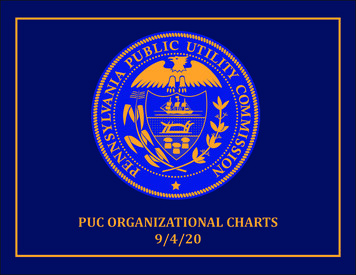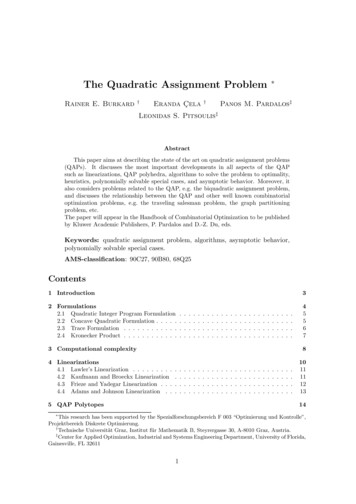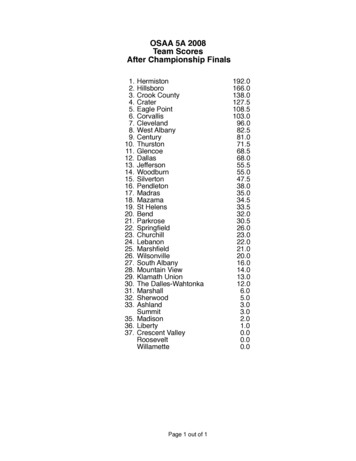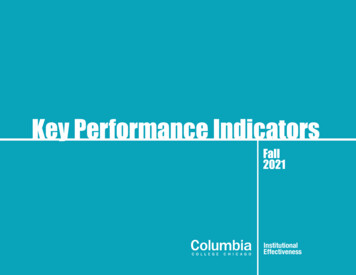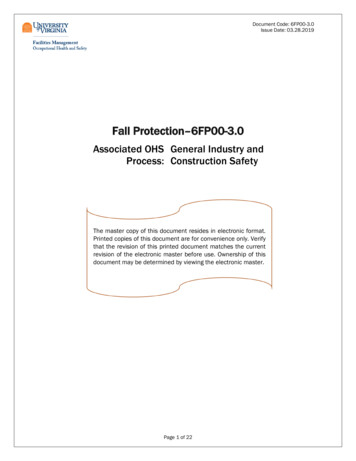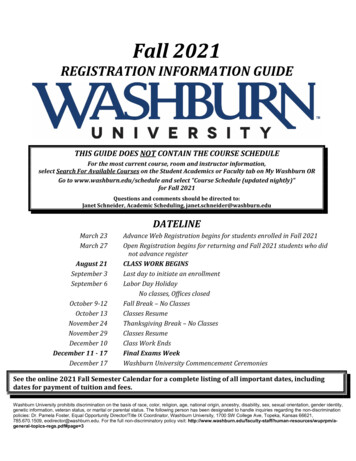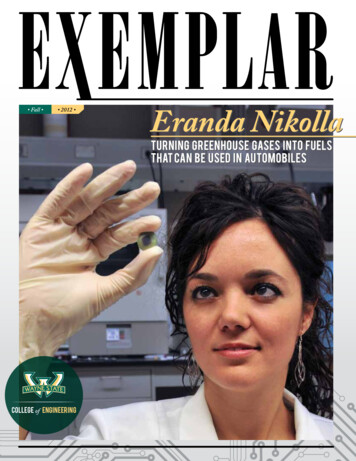
Transcription
Fall 2012 Eranda NikollaTurning greenhouse gases into fuelsthat can be used in automobilesCollege of engineering
Wayne State University Board of GovernorsTina Abbott, chairPaul E. MassaronDebbie Dingell,Annetta Millervice chairGary S. PollardEugene DrikerAllan GilmourDiane L. Dunaskissex officioDanialle KarmanosWayne State University PresidentAllan D. GilmourCollege of Engineering DeanFarshad FotouhiAssociate Deanfor Research andGraduate StudiesSimon NgAssociate Dean ofAcademic Affairs andStudent ServicesR. Darin EllisChair, BiomedicalEngineeringJuri GelovaniChair, ChemicalEngineering andMaterials ScienceCharles MankeChair, Civil andEnvironmentalEngineeringJoseph HummerChair, Electrical andComputer EngineeringYang ZhaoChair, EngineeringTechnologyC.P. YehChair, Industrial andSystems EngineeringLeslie MonplaisirChair, MechanicalEngineeringWalter BryzikDesignJoseph BowlesPhotographyRick BielaczycMary Jane MurawkaChair, ComputerScienceXue-wen ChenExemplar is published for alumni and friends ofthe College of Engineering.Wayne State UniversityCollege of Engineering5050 Anthony Wayne DriveDetroit, MI 48202engineering.wayne.eduCOLLEGE of ENGINEERINGTable of ContentsGreen EnergyA powerhouse in green technologies. 2College professors conducting green research. 3EcoCAR 2 team revs up in second year. 4Discovering green energy conversion and storage systems. 5Southeast Michigan Advanced Energy Storage System Initiative. 5Minimizing energy consumption of mobile devices. 6Enhancing the green supply chain. 7Select green research awards and technologies. 8Improving battery performance. 9Keeping our parks and beaches clean. 10GreenUp. 11Powering the future. 12Alumna works toward a sustainable future. 13Year in ReviewFall 2012 admissions statistics. 14Commencement, Order of the Engineer, POET. 15College highlights. 16Night of the Stars . 17International outreach. 18Biomedical engineering. 19Chemical engineering and materials science. 20Civil and environmental engineering. 21Computer science. 22Electrical and computer engineering. 23Engineering technology division. 24Mechanical engineering. 24Industrial and systems engineering. 25Giving and class notesBoard of Visitors sets the bar. 26Recent gifts and scholarships. 27College activities. 28A letter from EAAB President John Micheli. 29Alumni statistics. 30Class notes. 31Remembering. 32
Greetings from the DeanDear alumni and friends,On behalf of the Wayne State College of Engineering, I am pleased to present thisedition of Exemplar magazine. We have experienced great successes over the past year— including a more than 20 percent growth in undergraduate enrollment and nearly10 percent growth in graduate enrollment — and are thrilled to share some of thosewith you in this publication.One of my priorities as dean is to enhance the College’s already strong reputationas a leader and pioneer in green technologies. We have great strength and promisein this area, with the innovative research, evolving courses, practical experienceand internship opportunities, and more to make this priority a reality. As part of thisinitiative to bring awareness to all our College of Engineering community does, thisedition of Exemplar focuses largely on our efforts in green technologies.Our faculty is on the forefront of green technologies in many ways. Whether they are identifying new fuel resources,powering buildings and cities with alternative energy, creating greener products, enhancing the green supply chain,increasing energy storage, optimizing sustainable water transmission and delivery, or more, our faculty membersare making a name for the College on the national and international stage. Take, for instance, Assistant Professor ofCivil and Environmental Engineering Jaewon Jang, whose research on methane hydrates was one of just 13 relatedprojects recently funded by the Department of Energy, or Associate Professor of Computer Science Weisong Shi, whois minimizing energy consumption of mobile devices. Or, the work of chemical engineering professors Simon Ng andSteven Salley, who developed NextCAT, Inc., to commercialize a class of catalysts that enable biodiesel producers toconvert cost-effective raw materials into biodiesel. This edition of Exemplar highlights just a few of our many greenexpert faculty members.Green technologies span across a variety of engineering disciplines, and we are focused on providing ourstudents with the greatest opportunities possible throughout all our departments. Our students learn from expertfaculty members — more than one-third of whom conduct green research. Our students have access to studentorganizations, competitions and internships that help foster a greater understanding and exploration of alternativeenergy, green technologies and sustainability. They also learn and conduct research in a LEED-certified facility.The College of Engineering plays an integral role at the University in this area. Additionally, the University as a wholehas led and undertaken many efforts to help showcase Wayne State’s role as a green leader. Some of the University’smany green projects and initiatives include the creation of the Urban Watershed Environmental Group, theWater@Wayne seminar series, Zipcar and Zimride programs, the Sustainability@Wayne recycling effort, the Switch ItOff energy conservation campaign, and green roofs. As you can see, Wayne State and its College of Engineering areleading the way in green technologies. Our students, faculty and alumni are engineering Detroit — and their world— each and every day.We hope you enjoy this issue of Exemplar magazine. Please be sure to read our Year in Review section to get a greatersense of the many additional successes the College community has celebrated throughout the year, such as the hiringof three remarkable researchers and scholars — Xue-wen Chen, Juri Gelovani and Joseph Hummer — as departmentchairs. It is indeed a great time to be a Wayne State engineering alumnus, student or friend.Farshad FotouhiDean, College of EngineeringWayne State University1
The Wayne StateCollege of Engineering:a powerhouse ingreentechnologiesCOLLEGE of ENGINEERINGt Wayne State’s College of Engineering is a primary,go-to center for alternative energy and electricdrive vehicle education, curriculum research anddevelopment in Michigan.t The College is home to the nation’s first electric-drivevehicle engineering program and alternative energytechnology master’s degree program.t Many of our faculty members conduct research at theNational Biofuels Energy Lab.t Our Center for Automotive Research conductsinterdisciplinary research on alternate and renewablefuels and biofuels.t The College has invested 1.2 million in newequipment for alternative energy research.t The Department of Energy, the National ScienceFoundation, the Michigan Department ofEnvironmental Quality — and many more — supportand partner with the College in its green research,symposia and conferences.tA large percentage of courses offered at the Collegeinfuse green technologies and sustainability intoclassroom learning.tM ore than one-third of full-time College ofEngineering professors conduct green research withtheir students.tW e support innovation and entrepreneurship,providing students, alumni and faculty with servicesand connections to help commercialize greentechnologies and launch businesses.tW e have alumni in every state and 48 countries, manyof whom are focused in the areas of alternative energyand sustainability.Deputy Secretary ofEnergy visits WSU,meets with College ofEngineering studentsCollege of Engineeringstudents met with DeputySecretary of Energy DanielPoneman for a roundtablediscussion in May. Ponemanspoke on the importanceof supporting students intheir pursuit of affordablehigher education and STEMrelated degrees in order tosecure good jobs, strengthenU.S. competitiveness in theglobal clean energy race, andadvance an “All of the Above”energy strategy.2
Morethanof Full-Time College ofEngineering professorsconduct reen researchgJerry Ku, alternative energy technology,electric-drive vehicle engineeringEmmanuel Ayorinde, nondestructiveevaluationMing-Chia Lai, bio-fuel combustionand emissions, fuel cell, fuel reforming,alternative energy technology, electric-drivevehicle engineeringAmar Basu, biotechnology for renewablebiofuels, environmental sensors forpreventing invasive species in the GreatLakesKenneth Chelst, alternative energytechnologyWen Chen, electric-drive vehicleengineering, alternative energy storageMark Ming-Cheng Cheng, batterymaterials, battery diagnosis andcharacterization, environmental sensorsRatna Babu Chinnam, sustainable supplychains, design for sustainabilityHamidreza Chitsaz, optimization of algaefor biofuel productionDa Deng, energy storage, green chemistry,environmental remediationAna Djuric, production planning for greenmanufacturingSorin Draghici, power-efficient processingon large servers and distributed computingenvironmentsNathan Fisher, power-aware real-time andembedded computing systemsNaeim Henein, alternative fuel enginetestingYinlun Huang, sustainable product andprocess engineering, manufacturingsustainability, sustainable nanotechnology,material and energy system integrationMarcis Jansons, advanced enginecombustionKyoung-Yun Kim, alternative energytechnology, electric-drive vehicleengineering, sustainable productdevelopmentGene Liao, electric-drive vehicleengineering, hybrid vehicle powertrain,advanced energy storage systemsFeng Lin, electric-drive vehicle engineering,hybrid systems, smart grids, alternativeenergyJohn Liu, electric-drive vehicle engineering,advanced embedded systemsShawn McElmurry, urban agriculture,water quality, sustainable energyGrace Metri, energy efficiency of datacentersCarol Miller, streamflow, landfillmanagementLeslie Monplaisir, product developmentfor alternative energy technology, designfor sustainabilityAlper Murat, sustainable logistics andgreen supply chain managementSimon Ng, alternative energy technology,electric-drive vehicle engineeringEranda Nikolla, chemical, electrochemicaland photochemical routes for energyconversion and storageRobert Reynolds, social sustainability,including urbanization and builtenvironments, terrestrial hazards anddisasters, and land use and landscapes ofproductionSteven Salley, alternative energytechnology, electric-drive vehicleengineeringWeisong Shi, power and energy efficiencyof networked computer systems andapplicationsGina Shreve, biotechnology for biofuelproduction, environmental sensors,aqueous waste stream minimization andremediationHarpreet Singh, intelligent approaches inimproving in-vehicle network architectureand minimizing power consumption incombat vehicles, energy saving in ArmyvehiclesChin-An Tan, motion-based energyharvestingGreen TechnologiesFaculty members conducting greenresearch projects:Caisheng Wang, electric-drive vehicleengineering, alternative energy storagesystemsLe Yi Wang, alternative energy technology,electric-drive vehicle engineering, smartgridsJim Woodyard, thin-film photovoltaicsHwai-Chung Wu, green and sustainablebuilding and pavement materialsXin Wu, lightweight material and life cycleanalysisKing Hay Yang, crashworthiness oflightweight materials to reduce vehicleweightQingyu Yang, reliability and optimalmaintenance, sustainable productmanufacturingEce Yaprak, electric-drive vehicleengineeringChih-Ping Yeh, electric-drive vehicleengineering, advanced energy storagesystemsHongwei Zhang, wireless sensing andcontrol networks for smart electric gridNabil J. Sarhan, energy-efficient automatedvideo surveillance systems3
2COLLEGE of ENGINEERINGEcoCARteam revsup in second yearWayne State University’s EcoCAR 2team — Michigan’s only competinguniversity team and one of just 15teams throughout North America— successfully earned its spot in thesecond year of the EcoCAR 2:Plugging in to the Futurecompetition. After a year of planningand designing, the team is nowimplementing its parallel throughthe-road (PTTR) architecture.Accompanied by WSU PresidentAllan Gilmour, College of EngineeringDean Farshad Fotouhi, and EcoCar 2ECE students win 50,000in Michigan Clean EnergyChallengeFaculty Advisor Jerry Ku, the EcoCAR2 team received its Chevy Malibu andcelebrated the support of its teamsponsors at a June event.Three electrical and computerengineering doctoral studentswon the 50,000 first prizein the Michigan Clean EnergyVenture Challenge for theirunique energy-harvestingtechnology.The annual challenge,established by the Universityof Michigan and DTE Energy,encourages students fromMichigan colleges anduniversities to grow cleanenergy solutions into thrivingbusinesses.Students Yating Hu, HongenTu and Junhui Zhao werenotified of their win inFebruary 2012.Photo by Marcin Szczepanski/University of Michigan, COEMultimedia Producer“ I’m getting hands-on experience as the EcoCAR 2 team captain.And I’m already working full-time as a battery engineer atALTe Powertrain Technologies as I finish my degree.”— Idan Regev, alternative energy technology student4
The Nikolla group combinestheoretical and experimentalapproaches in her research to designactive and stable materials for energysystems.“Development of robust materialsfor renewable energy conversionand storage systems would makeautomobiles, homes and our dailylives much more energy efficientand environmentally friendly,”said Nikolla, who currently leadsa research team of two doctoralstudents, one master’s student andtwo undergraduate students.Discovering green energyconversion and storage systemsEranda Nikolla, chemical engineeringassistant professor, is hoping toimprove energy efficiency and more.Her goal is to improve energyefficiency and storage — andlessen environmental pollutantsand emissions — throughthe development of robustelectrochemical and photochemicalenergy systems.The highly sought-after scholar, whoreceived a number of professorshipoffers after receiving her doctoratedegree in chemical engineering fromthe University of Michigan, has beenresearching fuel cells and renewableenergy systems since beginning hergraduate program at the Universityof Michigan. While at U of M, sheearned the prestigious DistinguishedDissertation Award for her thesis.She then moved to the CaliforniaInstitute of Technology asa postdoctoral scholarto work on chemicalprocesses forconversion ofbiomass intouseful fuels andchemicals.“Engineers createour future innearly every senseof the word.”- Nikolla“It is muchmore efficientto convertchemical energy toelectrical energy usingelectrochemical systems asopposed to combustion systems thatwe currently use,” she said. “Fuel cellvehicles on the market today, whileimpressive, are still in their infancyand tend to be more expensive thanstandard vehicles. Motivated bythis fact and the desperate need formore energy efficient systems, myresearch focuses on the developmentof robust, affordable and abundantmaterials for photo-electrochemicalenergy conversion and storagesystems.”Green TechnologiesDwindling fossil fuel resources andhigh greenhouse gas emissions haveincreased the need for more efficientand environmentally friendly energyconversion and storage systems.“We are currently working onrecycling atmospheric CO2, agreenhouse gas, into fuels that canbe used in automobiles. We are alsoworking on developing renewableenergy conversion systems involvingsolar energy and biomass. Ourresearch approach allows usto develop a fundamentalunderstanding ofthese processes thatcan be utilized asa tool to developrobust materials,”said the passionateexpert, whoseresearch could havesignificant implicationsfor consumers, corporationsand suppliers here in the UnitedStates and abroad.Between her research, teaching,supervising and finding funding forher lab, Nikolla also makes a point topromote STEM disciplines to youngwomen.“Engineers create our future in nearlyevery sense of the word. I want tomake sure high school students,especially young women, knowwhat kind of careers are available inengineering.”A Southeast Michigan Advanced Energy Storage System Initiative partnerWayne State University is a partner ofthe collaborative Southeast MichiganAdvanced Energy Storage SystemInitiative (AESSI), which received a 2.1 million federal grant last yearas part of President Barack Obama’sJobs and Innovation AcceleratorChallenge. The initiative aims tocreate new jobs and technologiesrelated to rapidly emergingadvanced energy storage systemsin Southeast Michigan. The Divisionof Engineering Technology isresponsible for delivering professionaldevelopment courses in six topicscritical to AESSI: Fundamentalsof Electrochemistry for Battery,Advanced Battery Systems for VehicleElectrification and Hybridization,Advanced Energy Storage Systems,Introduction of Battery ManagementSystems, Battery Manufacturing, andSafety of High Voltage Battery.5
COLLEGE of ENGINEERINGMobile phoneapplicationshelp us finddirections,read the latestheadlines, playgames andstay connectedon Facebook,but theseapplicationscan take a toll on the battery life ofmobile devices, ultimately increasingour energy consumption. WeisongShi, associate professor of computerscience and director of the Mobileand Internet SysTems Laboratory(MIST), has created a service called“Bugu” for mobile devices (such assmartphones and tablets), that aimsto decrease energy consumption ofapplications.Bugu has two main components:the client side analyzes the powerbehavior (or the patterns of energyconsumption) of applications thatare installed on a mobile device, andthe Bugu server provides users withan overview of this power behavior.A user installs Bugu on a mobiledevice, and the Bugu server, locatedin the computer science server room,analyzes the power behavior data ofthe device’s applications.Shi and computer science doctoralstudents Youhuizi Li and Hui Chenbelieve that Bugu will benefit threegroups: end users, mobile applicationdevelopers and system developers.“As an end user, we want to knowwhich applications are more energyfriendly,” said Shi. “Applicationdevelopers want to know why theirapplications consume the amountsof power that they do. Systemdevelopers, who look at the bigpicture of how applications and amobile system work together, wantto understand energy consumptionof running applications so that theycan then optimize whole systemenergy consumption.”The overview of power behaviorthat Bugu provides will allow endusers to select applications that aremore energy-friendly and will allowapplication and system developersto better understand energyconsumption and optimize theirproducts for better energy efficiency.The Bugu service is now availableto the public and can be found atcodegreen.cs.wayne.edu/bugu.Water@Wayne Seminar Series features Adjunct Professor Kurt HeiseAdjunct Professor Kurt Heise presented “The DetroitWater and Sewerage Department (DWSD) – ThePolitical and Environmental Impact of a Utility inTransition” as part of the Water@Wayne seminarseries in April 2012. Heise discussed the provision ofwater and sewerage services, which are among themost contentious political and environmental issuesin Southeast Michigan.6
Enhancing the green supply chainRatna BabuChinnam,industrialand systemsengineeringprofessorand graduateprogram chair,likes solvingcomplex puzzles.His research, which focuses on supplychain management, sustainability andoperations management, has helpedbusinesses and corporations savemoney, improve quality and enhanceefficiency for more than a decade.Delphi, at the time, was developingits remanufacturing business thatfocused on re-using old products.They were interested in Chinnam’sadvice on how to better manage thereverse supply chain.“In growing their new business, theywanted to make sure they maintainedtheir reputation by not running outof product for customers and at thesame time maintain profit margins.Chinnam’s group delivered.He and his doctoralstudents built models togive them guidance onhow to estimateflows and manageproduction.His students,who both haverecently becomefaculty membersat prestigiousinstitutions inTurkey andIndia, completeddissertations usingDelphi data sets todevelop decisionsupport models.Specifically, theydeveloped modelsto optimize theproduct launchtiming for newproducts, betteranticipate productreturns from customers, and installthe right production capacity forremanufacturing.Those models, dissertations andguidance have helped Delphi’sreverse supply chain business ensureappropriate remanufacturing capacityand efficient delivery of products.Delphi’s reverse supply chain businessnow operates with more than 1,000employees.Chinnam’s experience with Delphi,according to the India native andRochester, Mich., resident, wasjust the beginning for his researchinto green supply chains. Thoughfocused on a wide variety of researchprojects — streamlining patient flowsat hospitals, more efficiently movingjust-in-time freight, developingtools for automotive companies tomanage product assortments — heis well aware of the growing need forgreen supply chain and operationsmanagement research. He servesas one of the two North Americaneditors for the new Journal ofRemanufacturing.He said, “People’s perceptions arechanging. They’re saying, ‘Where didthis product come from? How is itmade?’ More people are interestedand caring about more sustainablepractices, and there’s more pressureon companies to be good corporatecitizens. That, and the fact that supplychains have become unsustainableas they currently exist. There is agreater need for local production andimproved supply chain sustainability.”Green TechnologiesCombine his passion for problemsolving, a keen interest in operationsmanagement and a growingconcentration on green technologies,and it is easy to see why DelphiAutomotive contacted Chinnamdirectly for assistance nearly sixyears ago.They wanted guidance on operations,inventory and timing the launch ofproducts,” Chinnam said.Without a doubt, Chinnam’s researchwill help shape the future of greensupply chain management.College of Engineering celebrates LEED Silver CertificationThe Marvin I. Danto Engineering Development Center (EDC)was designated a U.S. Green Building Council LEED SilverCertified facility — the first Wayne State University buildingto receive the honor. The 82,500-square-foot building,completed in 2009 at a cost of 27.3 million, providesan advanced technology facility for engineering researchon WSU’s Midtown campus. Leadership in Energy andEnvironmental Design certification is achieved by meetingspecific requirements in five environmental categories — sitedevelopment, water savings, energy efficiency, materialsselection and indoor environmental quality. In April, WayneState unveiled a plaque in recognition of the EDC’S LEEDSilver certification.7
Select recentgreen researchawards and TechnologiesCOLLEGE of ENGINEERINGUnlocking new energy resources Assistant Professor Jaewon Jang receiveda two-year, 178,000 grant from the U.S.Department of Energy to aid in the search formethane hydrates in oceans and permafrost,such as the Gulf of Mexico and Alaska’sNorth Slope.High-strength material advancementsmay lead to new, life-saving steelProfessor Susil Putatunda and a group ofcollege researchers are addressing the needfor structural components that are lighterand stronger, improve energy efficiencies,reduce emissions and pollution, increase safety andcost less to produce. His group has been working tocreate advanced materials with high-yield strength,fracture toughness and ductility. Their efforts have ledto the development of a new material consisting ofbainitic steels and austempered ductile iron that has allthese characteristics, ultimately resisting fatigue thatcan cause fractures in materials often with catastrophicconsequences. The austempering process is a moreenergy efficient heat treatment process that doesnot require post-heat treatment, therefore leading toadditional energy savings. This technology is ideallysuited for cast steel parts and is currently in themanufacturing validation development stage at asteel casting plant.Manufacturing innovation throughsustainable designProfessor Ratna Babu Chinnam wasawarded a 99,990 grant for his project,“Pan-American Advanced Studies Instituteon Manufacturing Innovation throughSustainable Design.” Chinnam will collaborate withKarl R. Haapala (Oregon State University), Gul OkudanKremer (Penn State University), and Ivan E. Esparragoza(Penn State University) on the project.Inventing a greener cementAssociate Professor H.C. Wu (Wayne State)and the NTH Consultants of Detroit jointlyfiled a utility patent for a product calledDetroit Cement. The team says the newformulation, created with the help of aPhase I Small Business Innovation Research grant fromthe National Science Foundation to NTH, is moreenvironmentally friendly and less costly than traditionalcements, while exhibiting improvement in several keyperformance characteristics.Advancing biofuel catalyst technologyNextCAT, Inc., a Wayne State Universitystartup company, received a Phase II SmallBusiness Innovation Research (SBIR) awardfrom the National Science Foundation (NSF)in the amount of 498,830. This bringsNextCAT’s total grant funding to 1.5 million. NextCATis working to advance a biofuel catalyst technologydeveloped at the National Biofuels Energy Laboratoryat Wayne State University.Preventing invasive species in theGreat LakesAssistant Professor Amar Basu, in collaborationwith WSU School of Medicine ProfessorJeffrey Ram, received an 800,000 awardfrom the Great Lakes Protection Fund for theirwork with environmental sensors for preventing invasivespecies in the Great Lakes. Professor Basu is also workingon a project with WSU School of Medicine ProfessorThomas Holland on biotechnology for renewable biofuels,developing an optical microplate, a high throughputscreening device that can be used to optimize lightconditions for maximizing the production of lipids inalgae. WSU Technology Commercialization is managingBasu’s technologies and a PCT patent application has beenfiled on his optical microplate invention.DAPCEP, ESFB help educate highschool students on renewableenergy alternativesEngineering Student Faculty Boardmembers are playing an active rolein the community. President NormDotson, for instance, is currentlythe engineering instructor for theDetroit Area Pre-College Engineering8Program (DAPCEP), where he has twosections of 30 high school students(66 students total). The focus of thissemester’s program is renewableenergy alternatives. One of theprogram’s first projects will be to buildand operate small fuel cell vehicles(hydro, solar, and hybrid cell vehicles).
In the Electric-Drive Vehicle Control and IntegrationLaboratory (EVCIL), Wang and his team are developingnew methods and algorithms that collect data on theindividual cells within a battery, and derive their modelsfor monitoring, diagnosis and control. By modelingbatteries, primarily lithium-ion, and integrating them intoa vehicle powertrain model, Wang wants to understandhow the batteries impact overall system response, such asstability, power efficiency, reliability and cost.Improvingbattery performanceLe Yi Wang, professor of electricaland computer engineering,alternative energy technology andelectric-drive vehicle engineering, and his collaborators,Electrical and Computer Engineering Professor Feng Linand Associate Professor Caisheng Wang, are lookingto find better ways to study and enhance batterymanagement systems.“I entered the Wayne AET program to be part of theever-increasing movement toward sustainability asnot only an environmental issue, but also a businessobjective. The AET program introduced me to currenttopics in alternative energy, while also preparingme with a variety of analysis, research and projectmanagement techniques. The job I ended up gettingwas advertised to me by my professor, and theBecause the characteristics of a battery systemchange while it is in operational use, due to aging,changes in operational conditions and variation inchemical properties, Wang hopes to develop a realtime automated battery characterizer that will captureindividualized characteristics of each battery cell duringbattery operations and support adaptation of batterymanagement strategies.“Battery cells have diversified char
Hamidreza Chitsaz, optimization of algae for biofuel production Da Deng, energy storage, green chemistry, environmental remediation Ana Djuric, production planning for green manufacturing Sorin Draghici, power-efficient processing on large servers and distributed computing environments Nathan Fisher, power-aware real-time and embedded computing .



